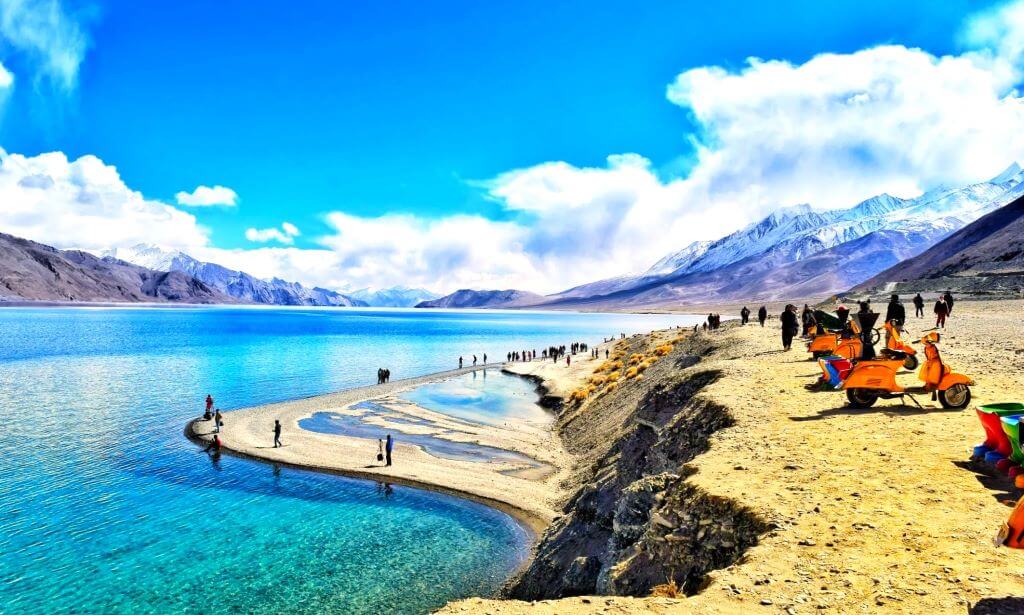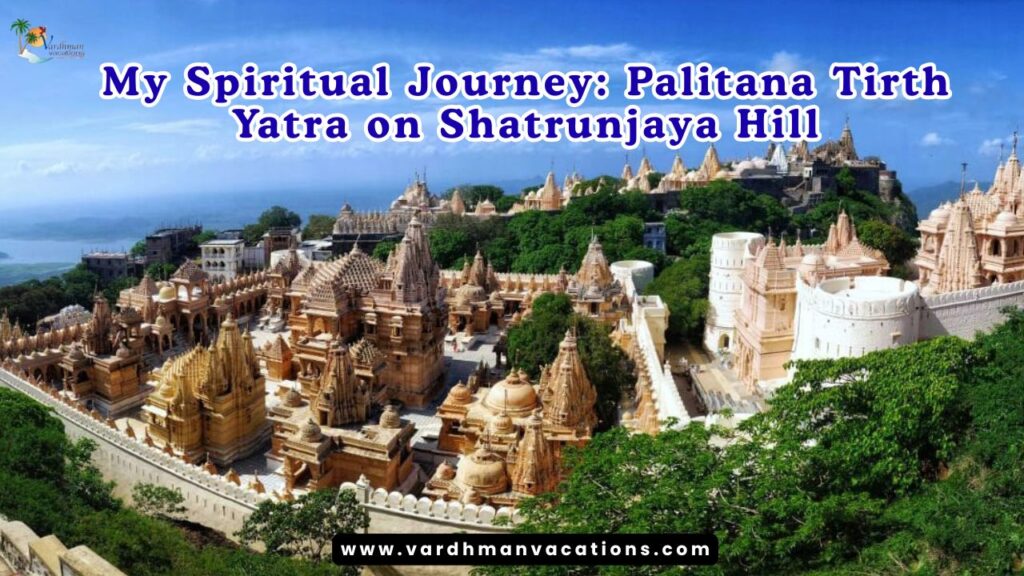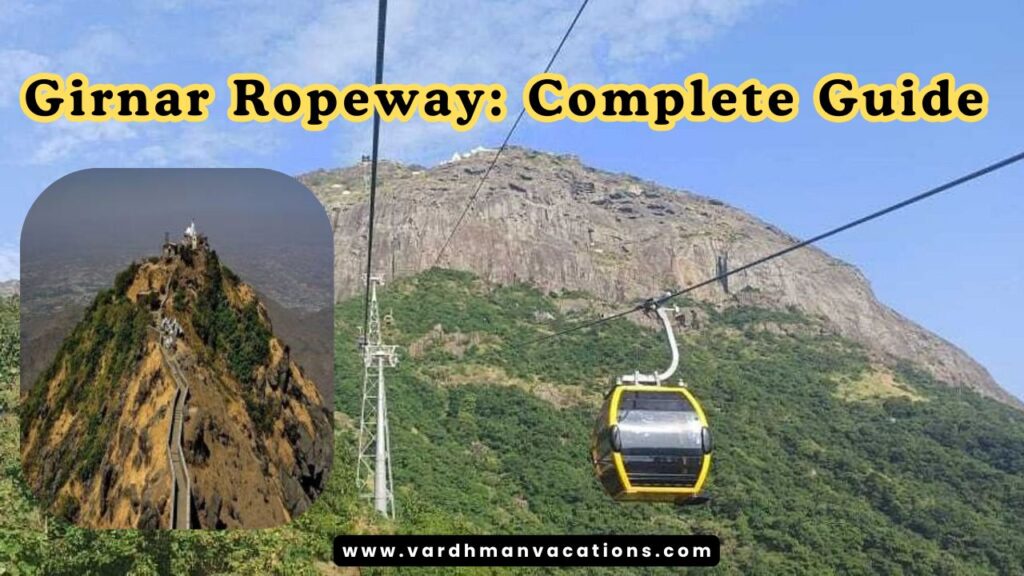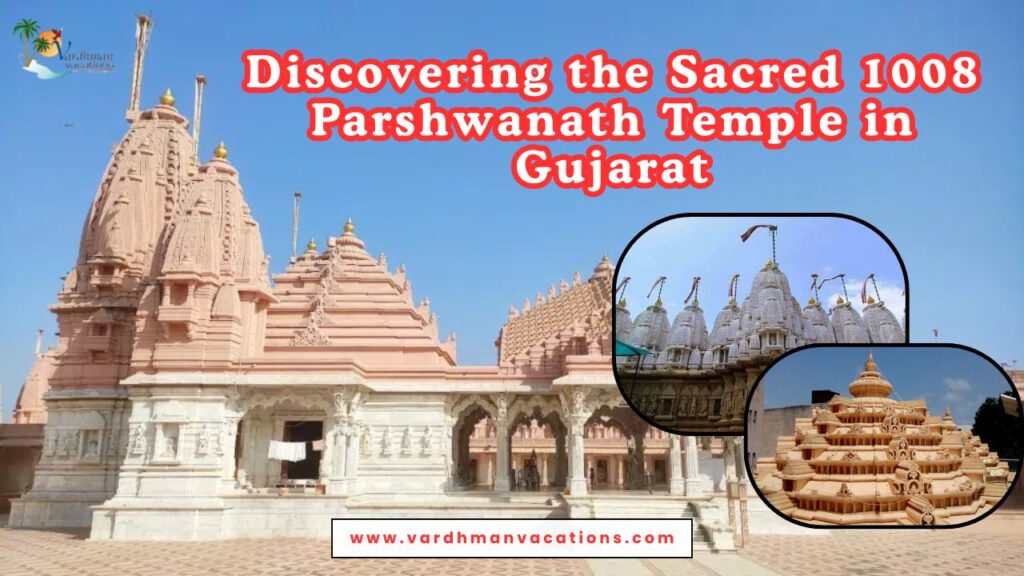Ladakh – the very name conjures up images of majestic mountains, crystal-clear lakes, and ancient monasteries nestled amid stark landscapes. Often referred to as “The Land of High Passes,” Ladakh is more than just a destination; it’s an emotion. Located in the northernmost part of India, this high-altitude desert is a dream come true for every traveler, adventurer, and soul-seeker.
With its dramatic terrain, vibrant culture, and spiritual calm, Ladakh offers a unique blend of natural beauty and cultural richness that captivates everyone who visits. Whether you’re a biker riding through treacherous mountain roads, a backpacker seeking serenity, or a photographer in search of raw, untouched beauty—Ladakh will leave you speechless.
In this blog, we’ll take you on a virtual tour of the must-visit places in Ladakh, from mesmerizing lakes and enchanting valleys to time-worn monasteries and hidden gems. Pack your bags (and your warmest clothes)—this journey to Ladakh is going to be unforgettable.
Pangong Lake – A Shimmering Blue Paradise
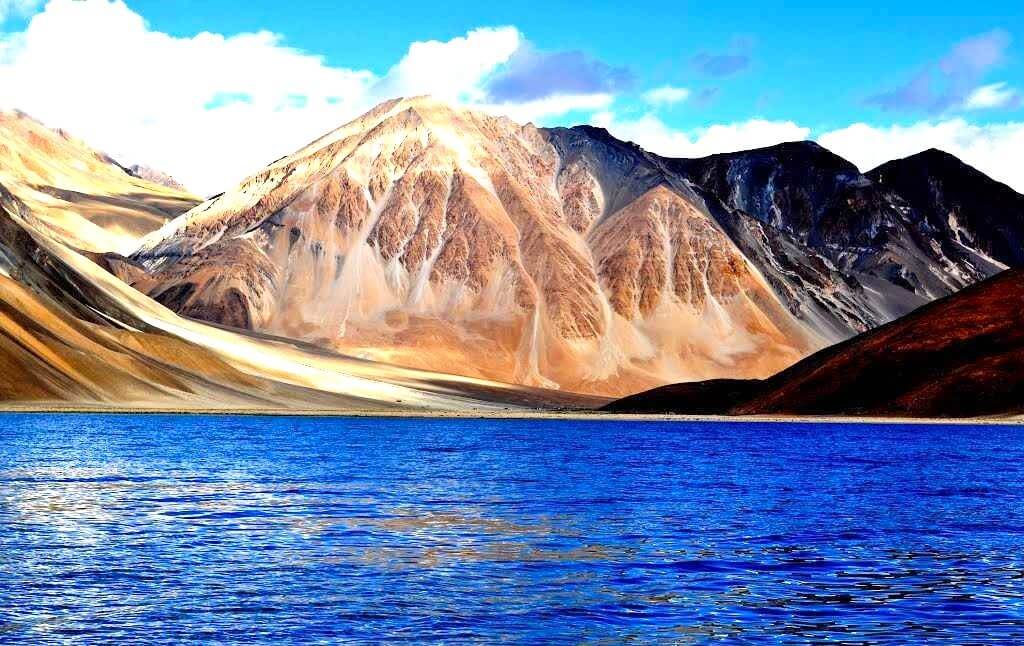
If there’s one place in Ladakh that has achieved iconic status, it’s Pangong Tso, commonly known as Pangong Lake. Situated at an altitude of about 4,350 meters, this enchanting lake stretches across India and China, with about 40% of it lying in India.
What makes Pangong Lake truly magical is its ability to change colors—from deep blue to turquoise to greenish grey—depending on the time of day and weather. The stillness of the lake, juxtaposed with the rugged mountains surrounding it, creates a surreal setting that feels straight out of a dream.
The lake gained massive popularity after being featured in the Bollywood film 3 Idiots, making it a bucket-list destination for many travelers. But beyond the cinematic fame, Pangong is a place that offers peace, serenity, and soul-stirring beauty.
Whether you’re camping by the lake under a sky full of stars or simply soaking in the view during the day, Pangong Lake leaves a lasting impression on everyone who visits.
Best Time to Visit: May to September (as the lake remains frozen during winter)
Things to Do: Camping, stargazing, photography, and enjoying the stunning sunrise and sunset views.
Khardung La – Gateway to the Nubra Valley
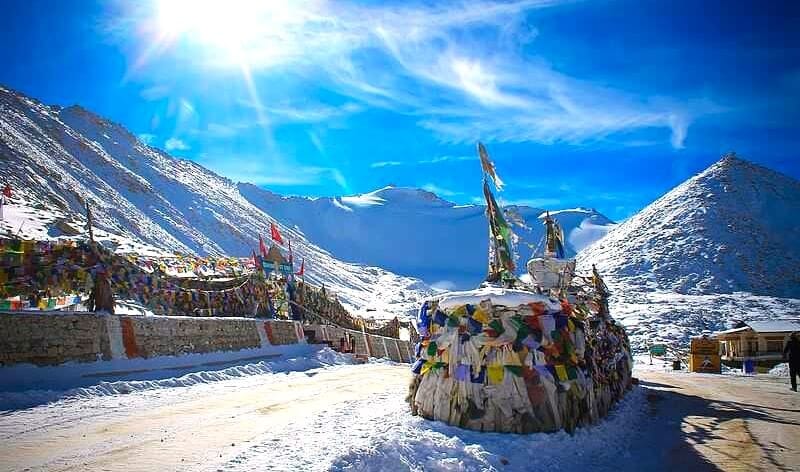
Welcome to one of the highest motorable roads in the world—Khardung La, perched at a dizzying height of 5,359 meters (17,582 feet) above sea level. This legendary mountain pass is more than just a high-altitude marvel; it’s a symbol of adventure, endurance, and thrill.
Located about 40 km from Leh, Khardung La connects Leh to the Nubra and Shyok Valleys and holds strategic importance for the Indian Army. But for travelers and bikers, it’s a bucket-list experience. Riding or driving through this rugged, snow-clad pass with prayer flags fluttering in the wind is nothing short of exhilarating.
Despite the chilly winds and thin oxygen levels, the views from the top are absolutely breathtaking. The snow-capped peaks, deep valleys, and vast expanses of untouched terrain create a cinematic panorama that stays etched in your memory forever.
Don’t forget to stop by the Khardung La Café and grab a hot cup of tea to mark your arrival at this iconic spot!
Best Time to Visit: May to October (the pass is usually closed during heavy snowfall)
Travel Tip: Acclimatize in Leh before heading to Khardung La to avoid altitude sickness.
Nubra Valley – The Desert in the Mountains
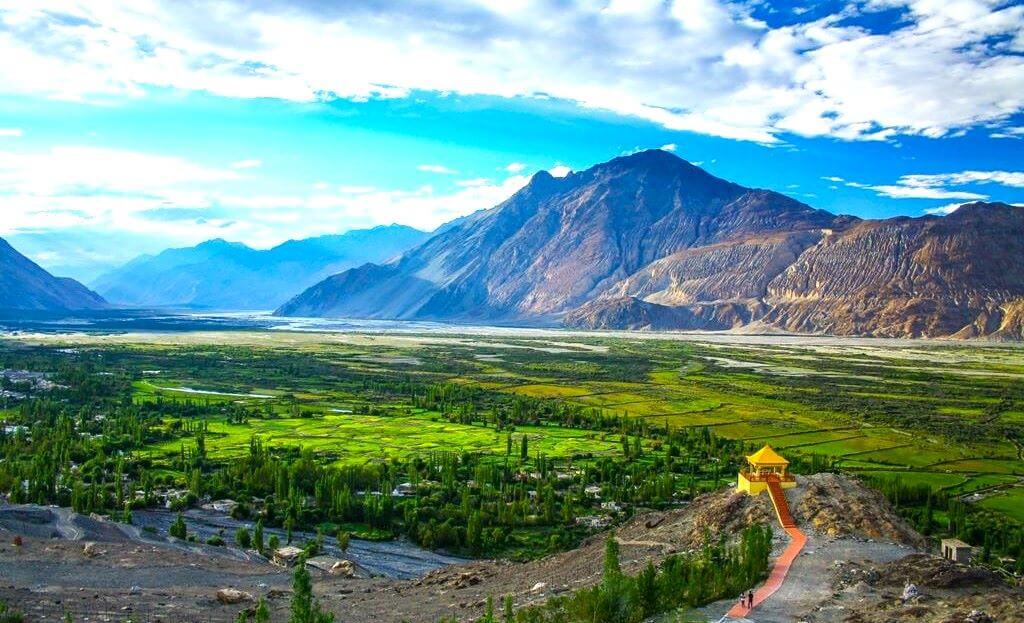
Tucked between the Karakoram and Ladakh ranges, the Nubra Valley is a landscape of stunning contrasts—sandy dunes and snow-capped peaks, lush green villages and barren cliffs—all coexisting in surreal harmony. Located about 150 km north of Leh, Nubra is often called “Ladakh’s Orchard” and “The Valley of Flowers”, thanks to its fertile patches and blooming apricot trees.
One of the most unexpected sights here is the cold desert of Hunder, where you’ll find Bactrian double-humped camels—a legacy of the ancient Silk Route trade. A camel safari across the sand dunes with views of towering mountains around is truly one of a kind.
Another highlight of Nubra is the quaint Diskit Monastery, perched on a hilltop, offering panoramic views of the valley. Don’t miss the towering 32-meter statue of Maitreya Buddha that watches over the land with serene grace.
The Shyok and Nubra rivers cut through the valley, creating lush green oases amid the arid terrain. The region’s unique blend of Tibetan and Muslim cultures, warm hospitality, and off-the-grid vibes make Nubra Valley a must-visit for anyone heading to Ladakh.
Best Time to Visit: June to September
Things to Do: Camel rides in Hunder, visit Diskit Monastery, explore Turtuk (a hidden gem near the Indo-Pak border), and stargazing in the clear night skies.
Leh Palace – A Glimpse into Ladakh’s Royal Past

Standing tall over the town of Leh, the majestic Leh Palace is a 9-storey royal structure that once served as the residence of the Namgyal dynasty. Built in the 17th century by King Sengge Namgyal, the palace is often compared to the Potala Palace in Lhasa, Tibet, due to its similar architectural style.
Though partially in ruins today, Leh Palace continues to whisper stories of Ladakh’s regal past. Its mud-brick walls, narrow stairways, and ancient wooden balconies exude a rustic charm, and its elevated position provides panoramic views of Leh town, the Stok Kangri mountains, and the Indus Valley below.
Inside, you’ll find old murals, thangkas (Buddhist scroll paintings), and artefacts that offer insights into the art and culture of Ladakhi royalty. The palace is now maintained by the Archaeological Survey of India, making it not just a visual treat but also a treasure trove for history lovers.
Climbing up to the top floors, especially around sunset, is an experience in itself—watching the golden light bathe the valley is absolutely mesmerizing.
Timings: 9:00 AM to 5:00 PM
Entry Fee: ₹15 (Indians), ₹100 (Foreigners)
Tip: Combine your visit with a walk through the old Leh town and nearby Shanti Stupa for a full cultural experience.
Magnetic Hill – Where Gravity Takes a Break
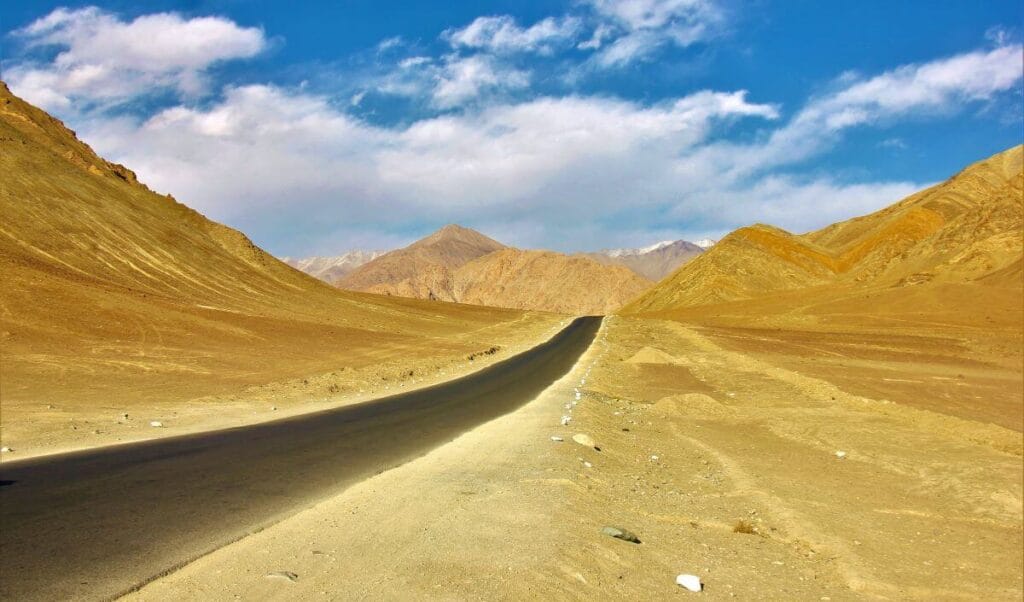
Imagine a place where your car seems to roll uphill on its own, even when the engine is turned off. Welcome to Magnetic Hill, one of Ladakh’s most intriguing natural phenomena and a hotspot for curious travelers and science buffs alike.
Located about 30 km from Leh on the Leh–Kargil–Baltic highway, Magnetic Hill is a gravity-defying marvel. There’s a marked spot on the road where, if you park your vehicle in neutral, it appears to move uphill slowly on its own. Some call it an optical illusion, while others believe in magnetic forces at play. Either way, it’s a thrilling and mind-boggling experience.
The surrounding landscape—with the mighty Himalayas as a backdrop and the Indus River flowing gently alongside—makes it a perfect place to pause, take photos, and soak in the mystique.
Adding to the charm is the nearby Sangam Point, where the Zanskar and Indus rivers merge—a stunning sight with striking color contrasts in the water.
Best Time to Visit: May to October
Things to Do: Test the magnetic effect with your vehicle, enjoy scenic photography, and stop by Sangam Point and the Gurudwara Pathar Sahib nearby.
Shanti Stupa – A Beacon of Peace Above Leh

Perched high on a hilltop in Chanspa, overlooking the town of Leh, the Shanti Stupa is not just a spiritual monument—it’s a place that radiates serenity and offers breathtaking panoramic views of the entire region. Built in 1991 by Japanese Buddhist monks as a symbol of world peace and unity, this white-domed stupa is a must-visit for both its spiritual significance and stunning setting.
The stupa enshrines relics of the Buddha, consecrated by the 14th Dalai Lama, and its two-level structure features beautifully carved panels that depict key moments from Buddha’s life. Whether you’re a pilgrim, a peace-seeker, or simply a traveler looking for a quiet escape, the Shanti Stupa offers a moment of reflection amid Ladakh’s raw natural beauty.
While it’s impressive at any time of day, the real magic unfolds during sunrise or sunset. As the golden light dances on the mountains and washes over Leh town below, the atmosphere turns almost ethereal.
You can either drive up or take the 500-step staircase to reach the top. The effort is well worth the reward.
Timings: 5:00 AM to 9:00 PM
Best Time to Visit: Early morning for sunrise or late evening for sunset views
Tip: Don’t rush—sit for a while, breathe in the silence, and let the peace of Shanti Stupa truly sink in.
Thiksey Monastery – Ladakh’s Mini Potala Palace
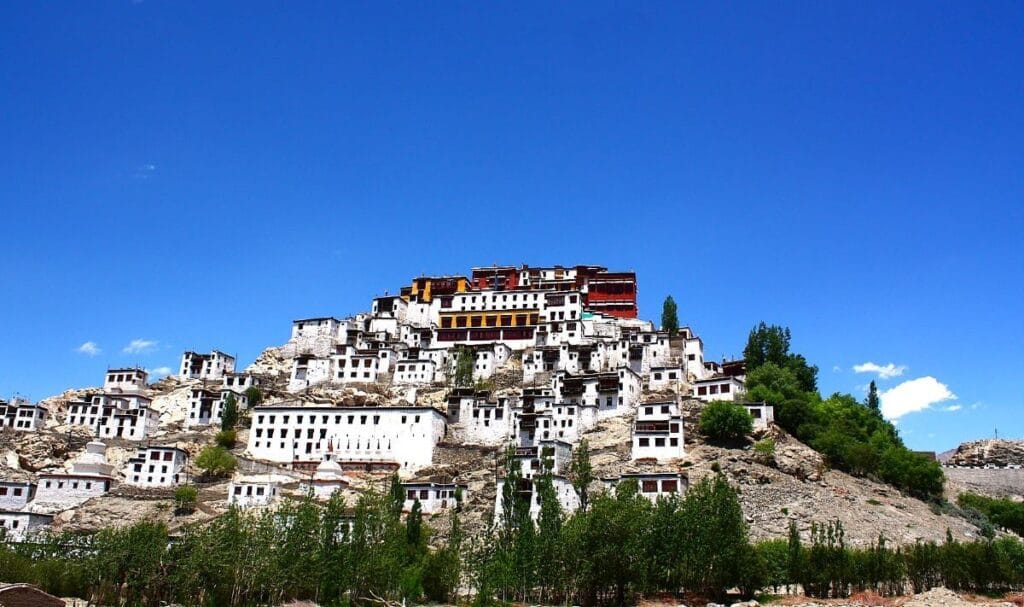
Rising majestically from a hilltop just 19 km from Leh, Thiksey Monastery is one of the largest and most architecturally impressive gompas in Ladakh. Often likened to the Potala Palace in Lhasa, this 12-storey structure cascades down the mountainside and houses monks’ quarters, temples, a nunnery, assembly halls, and a treasure trove of Buddhist art and scriptures.
Founded in the 15th century, Thiksey belongs to the Gelugpa (Yellow Hat) sect of Tibetan Buddhism. It is most famous for its stunning 15-meter-high Maitreya Buddha statue, which occupies two storeys and is one of the largest in Ladakh. The calm expression on the Buddha’s face, combined with the vibrant colors and ornate carvings, leaves a lasting impression on every visitor.
The monastery also offers a rare chance to witness morning prayer rituals—a powerful and peaceful experience where the sounds of chanting monks and resonating drums fill the ancient halls.
From the top, you’ll get sweeping views of the Indus Valley, the river, and distant Himalayan peaks—perfect for photographers and spiritual seekers alike.
Best Time to Visit: May to October
Timings: 7:00 AM to 7:00 PM
Don’t Miss: The morning prayer ceremony (usually starts around 6:00 AM), the library with ancient manuscripts, and the monastery café with serene views.
Zanskar Valley – The Untamed Heart of Ladakh
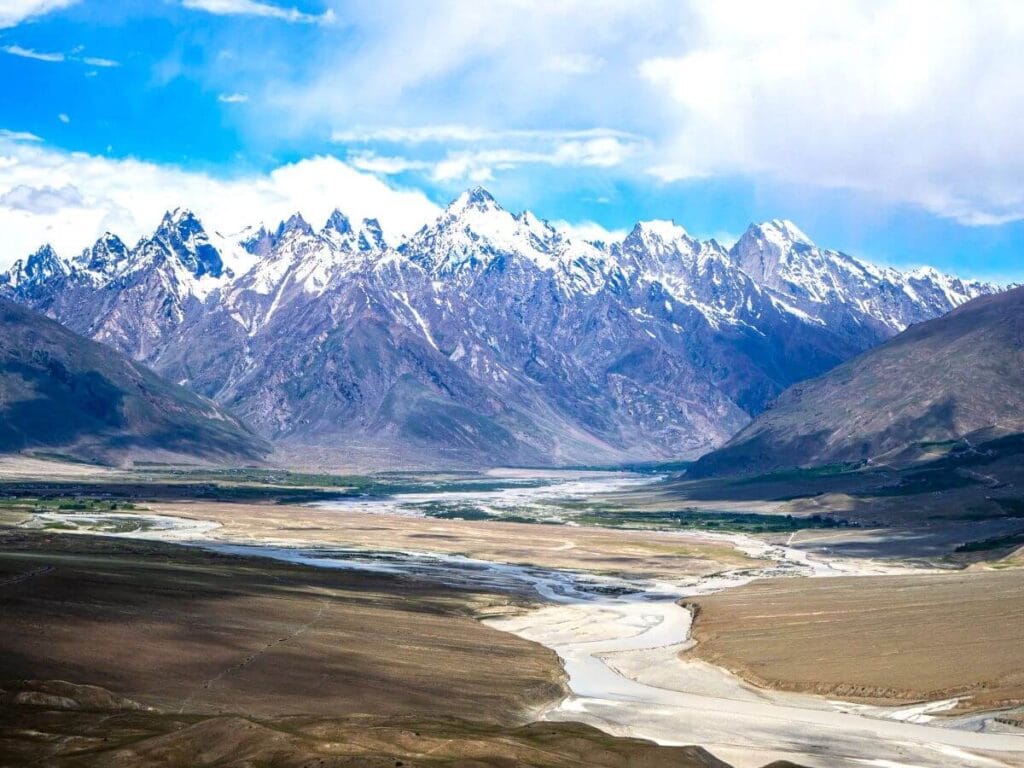
Remote, rugged, and spectacularly raw, Zanskar Valley is one of Ladakh’s best-kept secrets. Tucked away in the southeastern region of Ladakh, this isolated valley is a paradise for those seeking adventure, solitude, and unspoiled natural beauty. With its towering snow-capped peaks, crystal-clear rivers, and ancient monasteries, Zanskar feels like a world untouched by time.
The valley is inhabited by a small, resilient population that follows Tibetan Buddhism, and life here moves to the rhythm of nature and tradition. The Zanskar River, which cuts through deep gorges and glacial terrain, is also famous for the legendary Chadar Trek—a winter trail over the frozen river that challenges even the most seasoned trekkers.
In summer, the valley bursts into life, with lush meadows, colorful wildflowers, and surreal landscapes that feel almost alien. Places like Padum (the capital), Karsha Monastery, and Phugtal Monastery (built into a cave on a cliffside) offer a deep dive into both nature and spirituality.
Due to its remote location, reaching Zanskar isn’t easy—but that’s what makes it so magical. Every curve of the winding roads, every village tucked into a mountain, and every sunrise over the peaks feels like a reward earned.
Best Time to Visit: June to September (roads remain closed during winters due to heavy snowfall)
Things to Do: River rafting, trekking, exploring ancient monasteries, and cultural immersion in the local villages
Travel Tip: A journey to Zanskar demands time and patience, but it’s a once-in-a-lifetime experience for those who seek the wild side of Ladakh.
Tso Moriri – A Sacred Jewel in the Mountains

Less commercialized and more serene than its famous cousin Pangong, Tso Moriri is a hidden gem tucked deep within the Changthang Plateau at an altitude of about 4,522 meters (14,836 feet). This spectacular high-altitude lake lies in the Rupshu Valley, surrounded by snow-draped mountains and home to rare wildlife and migratory birds.
The moment you arrive at Tso Moriri, you’re struck by its tranquil blue waters, the symphony of silence, and a profound sense of peace that’s hard to put into words. Unlike Pangong, this lake is entirely within Indian territory and is considered sacred by the local Ladakhi people.
Declared a wetland reserve, Tso Moriri is a haven for bird watchers, especially during summer when you can spot black-necked cranes, bar-headed geese, and Brahminy ducks. The lake is also visited by kiangs (Tibetan wild asses) and other Himalayan wildlife, adding to its untouched wilderness charm.
Staying in the small nearby village of Korzok gives you a glimpse into the nomadic Changpa lifestyle, where yak herding and traditional living still thrive. Nights here are breathtaking—under a star-speckled sky, with nothing but the gentle breeze and the stillness of the lake.
Best Time to Visit: June to early September
Travel Tip: Tso Moriri is located in a sensitive border area; Indian tourists require an Inner Line Permit, and foreigners need a Protected Area Permit.
Things to Do: Photography, bird watching, stargazing, interacting with locals in Korzok village, and experiencing Ladakh’s quietest lake
Stok Palace – The Royal Residence of Ladakh
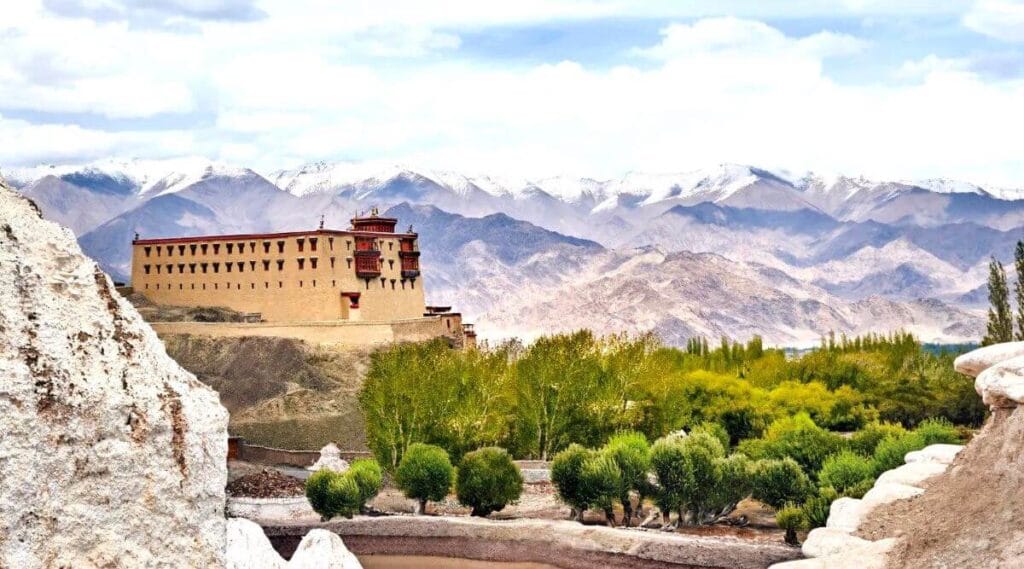
Nestled on the outskirts of Leh, Stok Palace is a stunning reminder of Ladakh’s regal heritage and remains the official residence of the Namgyal family, the former royal family of Ladakh. Situated at the foot of the Stok Kangri mountain, this 18th-century palace offers a unique blend of traditional Ladakhi architecture and royal history.
What makes Stok Palace particularly special is its location—surrounded by the rugged beauty of Ladakh’s mountains and offering panoramic views of the Indus Valley. The palace is divided into three sections: the main residence, the museum, and a small monastery that is still active today.
The Stok Palace Museum is a treasure trove of royal artifacts, including thangkas, ancient manuscripts, and personal belongings of the royal family, giving visitors a rare glimpse into the cultural and historical richness of Ladakh. One of the most intriguing items on display is the crown of the Ladakhi kings, which symbolizes the grandeur of the Namgyal dynasty.
If you’re in Leh, don’t miss out on a visit to Stok Monastery, located nearby, which houses a relic of the Buddha and offers a peaceful retreat with fewer crowds compared to other monasteries in the region.
Best Time to Visit: May to September
Things to Do: Explore the Stok Palace Museum, visit the monastery, enjoy the views, and learn about the Ladakhi royal legacy.
Hall of Fame – A Tribute to Ladakh’s Brave Heroes
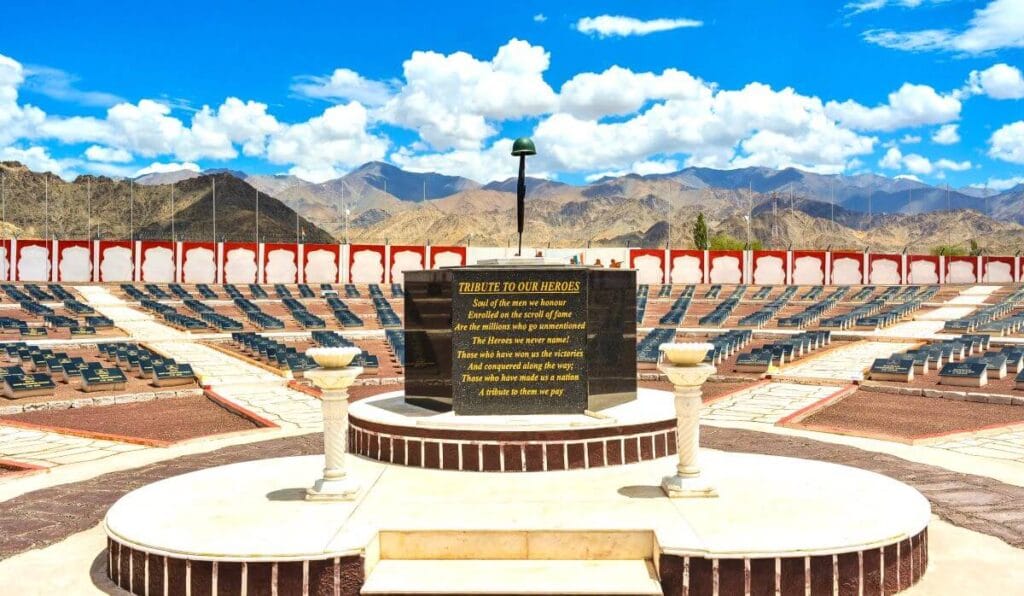
Located on the outskirts of Leh, the Hall of Fame is a must-visit for those who want to honor the sacrifices of the Indian Army and learn about the military history of Ladakh. This war memorial is dedicated to the soldiers who lost their lives during the 1962 India-China war, the Kargil War of 1999, and other border skirmishes, making it not just a museum but a place of reverence and respect.
The Hall of Fame is divided into several sections, each one narrating stories of bravery and patriotism. You’ll find detailed exhibits showcasing battle gear, war photographs, and plaques detailing the army’s efforts in Ladakh’s high-altitude terrain. The section dedicated to the Kargil War is especially moving, with photographs, battle maps, and personal accounts of soldiers’ heroism in the harsh conditions of the Kargil region.
Another fascinating aspect is the Kashmir section, which displays the rich cultural heritage of Ladakh and its strategic importance in Indian history. The artifacts, weapons, and memorabilia from the region provide an intimate understanding of the daily lives and sacrifices of those stationed in the harshest of conditions.
A visit to the Hall of Fame is both humbling and educational, allowing you to gain a deep appreciation for the men and women who defend this vulnerable and stunning part of India.
Best Time to Visit: Year-round, though it’s best visited during the summer months when the weather is milder.
Entry Fee: ₹25 (Indians), ₹100 (Foreigners)
Timings: 9:00 AM to 1:00 PM and 2:00 PM to 7:00 PM
Hemis Monastery – The Spiritual Heart of Ladakh
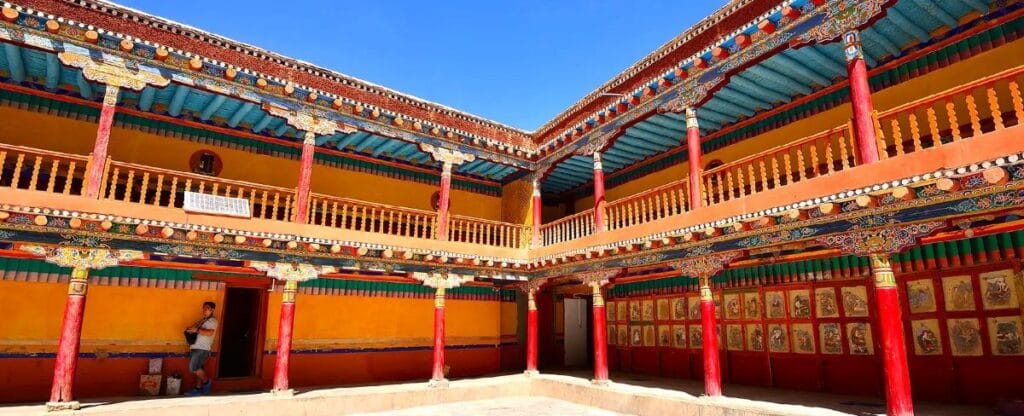
Nestled in the Hemis Valley, around 45 km from Leh, Hemis Monastery is one of the most revered and largest Buddhist monasteries in Ladakh. It belongs to the Drukpa Lineage of Tibetan Buddhism and is famous not only for its spiritual significance but also for its stunning architecture and historical importance.
The monastery’s majestic red and white structures stand against the backdrop of rocky cliffs and snow-capped peaks, making it a breathtaking sight for visitors. Hemis is most famous for hosting the Hemis Festival, an annual event that takes place in June or July to celebrate the birth of Guru Padmasambhava, the founder of Tibetan Buddhism. The festival features traditional mask dances, cultural performances, and vibrant celebrations, offering visitors a deep insight into Ladakh’s rich Buddhist traditions and rituals.
Apart from its grandeur during the festival, Hemis Monastery is home to ancient artifacts, thangkas, and an impressive collection of Buddhist scriptures. The monastery also houses a museum displaying precious historical artifacts, including rare Buddha statues, ritual instruments, and manuscripts.
The serenity and beauty of the monastery make it a peaceful retreat for travelers looking to soak in Ladakh’s spiritual essence. The monastery’s calm surroundings also offer a wonderful space for reflection and meditation.
Best Time to Visit: June to September (especially during the Hemis Festival for an authentic cultural experience)
Things to Do: Visit the monastery, explore the museum, witness the Hemis Festival, and enjoy the scenic beauty of the surrounding valley.
Sangam – Where Two Rivers Meet
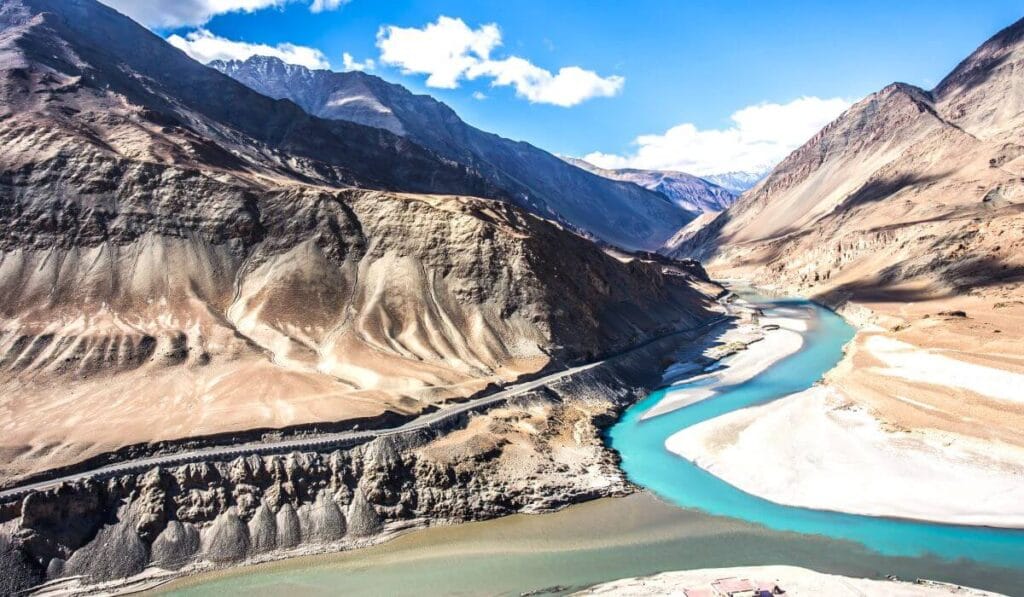
Located just 35 km from Leh, Sangam is where the Zanskar River and the Indus River come together in a spectacular confluence. This natural wonder is not just a geological marvel but also a stunning sight for anyone visiting Ladakh. The confluence of these two rivers, with their contrasting colors, creates an extraordinary visual effect, making Sangam a popular spot for photographers and nature lovers alike.
The Zanskar River, which is often a deep blue, meets the Indus River, which has a greener hue, resulting in an incredible visual contrast that’s almost unreal. The sight of the two rivers merging, especially in the background of the rugged Ladakhi mountains, creates a landscape so picturesque it feels like something straight out of a postcard.
Sangam is also a starting point for various river-rafting expeditions, particularly for the more adventurous travelers. The raft trips down the Zanskar and Indus Rivers offer a unique way to experience Ladakh’s landscape from the water, with towering cliffs, rocky terrains, and pristine views surrounding you.
Best Time to Visit: May to September (ideal for visiting and rafting)
Things to Do: Enjoy the stunning river confluence, take photos, indulge in river rafting, and admire the surrounding landscape.
Shey Monastery and Palace – A Glimpse into Ladakh’s Royal and Spiritual Past
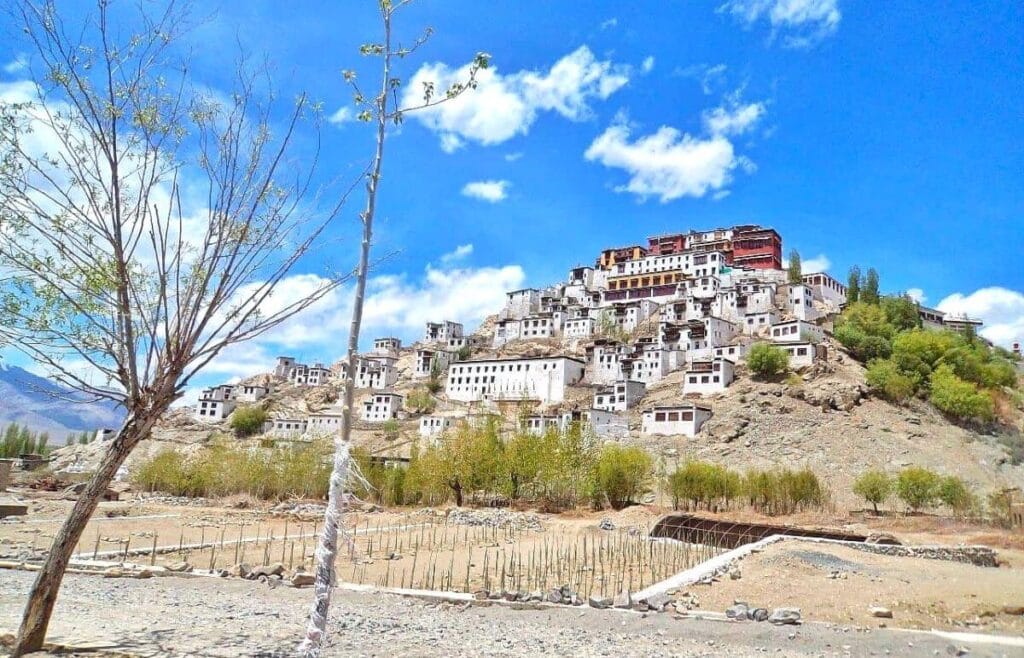
Located about 15 km from Leh, Shey Monastery and Shey Palace offer an intriguing combination of historical significance and spiritual serenity. Perched on a hilltop, the monastery and palace complex overlook the Indus Valley and provide panoramic views of the surrounding mountain ranges.
The Shey Palace was once the summer residence of the Ladakhi kings. Although much of the palace is in ruins, the imposing structure still carries an air of grandeur. It was built by King Deldan Namgyal in the 17th century and offers a glimpse into the royal lifestyle of Ladakh’s former rulers. The palace is characterized by traditional Ladakhi architecture and a unique multi-storey design, which is both simple and impressive.
The Shey Monastery, situated nearby, is famous for its massive statue of the Shakyamuni Buddha—one of the largest in Ladakh—standing at an awe-inspiring 12 meters. The monastery also houses several smaller Buddha statues, intricate murals, and thangkas, reflecting the rich Buddhist heritage of the region. The peaceful ambiance of the monastery, combined with the stunning views, makes it a wonderful spot for reflection and meditation.
Though less crowded compared to other famous monasteries in Ladakh, Shey Monastery and Shey Palace offer a quieter, more intimate experience of Ladakh’s royal and spiritual history.
Best Time to Visit: May to September
Things to Do: Explore the palace ruins, visit the monastery, admire the Buddha statue, and enjoy the breathtaking views of the valley below.
MoonLand – The Lunar Landscape of Lamayuru
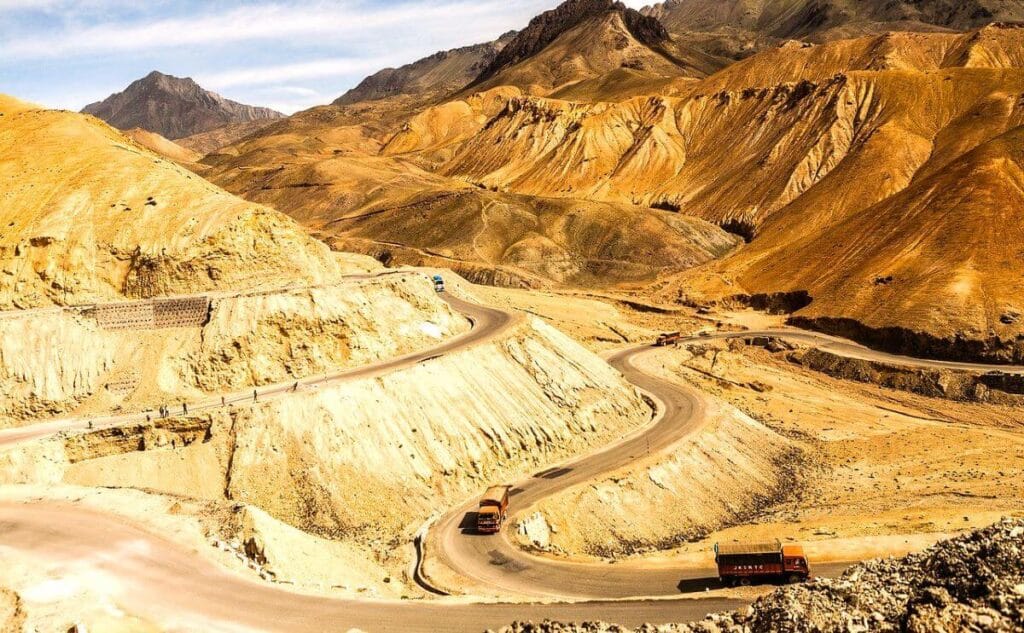
Located near Lamayuru Monastery, MoonLand is one of the most breathtaking natural landscapes in Ladakh, often described as resembling the surface of the moon. The surreal, otherworldly scenery of MoonLand is created by a series of rock formations, eroded cliffs, and deep valleys that give it a striking resemblance to a moon-like terrain—hence the name.
Lamayuru Monastery, one of the oldest and most significant in Ladakh, is situated nearby, and its red-and-white structures stand in contrast against the backdrop of this incredible natural wonder. The MoonLand is made up of yellow and brown hills, and the landscape is so distinct that it almost feels like stepping into a different planet. The area is also home to some interesting geological formations, which are a result of erosion over thousands of years, making it a fascinating spot for geology enthusiasts and photographers.
A visit to MoonLand is a peaceful experience, with minimal crowds and a serene, desolate beauty that will stay with you long after you leave. The quiet, almost mystical quality of the place makes it perfect for those seeking solitude, meditation, or simply a moment to absorb the majesty of nature.
Best Time to Visit: May to September
Things to Do: Explore the MoonLand landscape, take photographs, visit the nearby Lamayuru Monastery, and enjoy the view of the Himalayan ranges.
Rafting in Ladakh – Adventure on the Rivers

Rafting in Ladakh offers a thrilling way to experience its rugged beauty. The Zanskar and Indus rivers provide some of the best white-water experiences in India.
- Zanskar River Rafting: Known for its Grade II to IV rapids, rafting on the Zanskar offers breathtaking views of deep canyons and remote monasteries.
- Indus River Rafting: A gentler experience with moderate rapids, ideal for families and beginners. The stretch from Phey to Nimo offers stunning landscapes and peaceful waters.
Best Time to Visit: May to September for summer rafting; winter for the unique Chadar Trek experience.
Pathar Sahib Gurudwara – A Sacred Place of Peace and Miracles
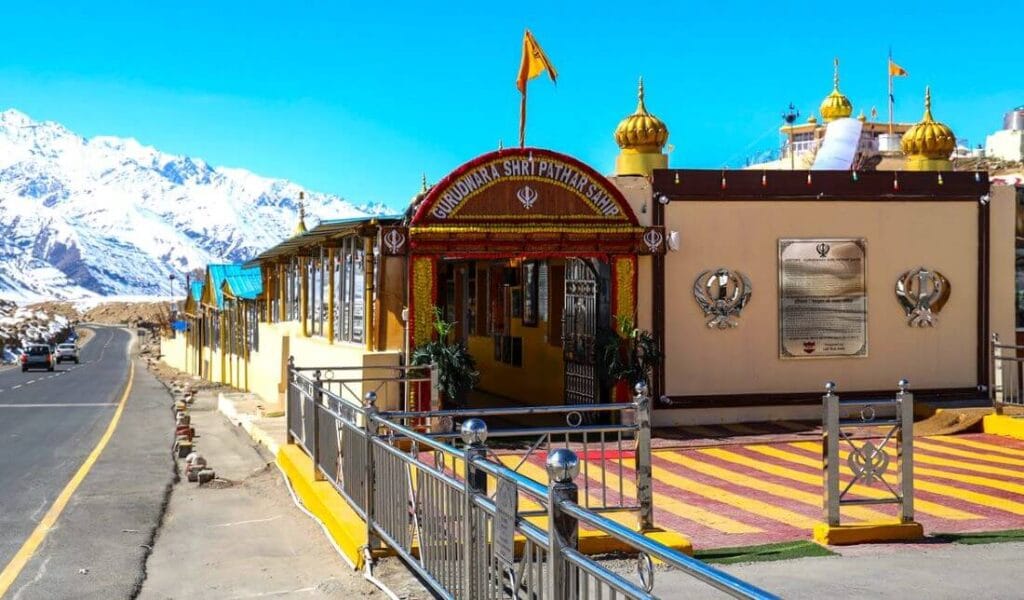
Situated about 25 km from Leh on the Leh-Kargil road, Pathar Sahib Gurudwara is a significant pilgrimage site for Sikhs and a peaceful place to reflect on the spiritual history of Ladakh. The Gurudwara, set amidst the stark beauty of the Ladakhi desert, is dedicated to Guru Nanak, the founder of Sikhism, who is believed to have visited this area during his travels.
According to local legend, the demon who once haunted the region tried to harm the Guru, but after a miraculous event, the rock in which he tried to strike Guru Nanak with his weapon was transformed. It is said that the rock bore the imprint of the Guru’s back and that the demon was defeated. The Pathar Sahib or “stone of the Guru” is now enshrined at the Gurudwara, making it a sacred and revered site for Sikhs.
The Gurudwara itself is a simple, white structure with a golden dome, and it radiates a sense of tranquility. The serene setting, combined with the warm hospitality of the monks who run the Gurudwara, makes it an ideal stop for reflection, prayer, or just to experience the peacefulness of the surroundings.
The Gurudwara is also a community hub where travelers are invited to share a meal at the langar (community kitchen), offering free meals to all visitors regardless of their religion or background.
Best Time to Visit: May to September
Things to Do: Visit the Gurudwara, reflect on the spiritual history, enjoy a peaceful moment, and participate in the langar.
Turtuk – A Hidden Gem of Nubra Valley
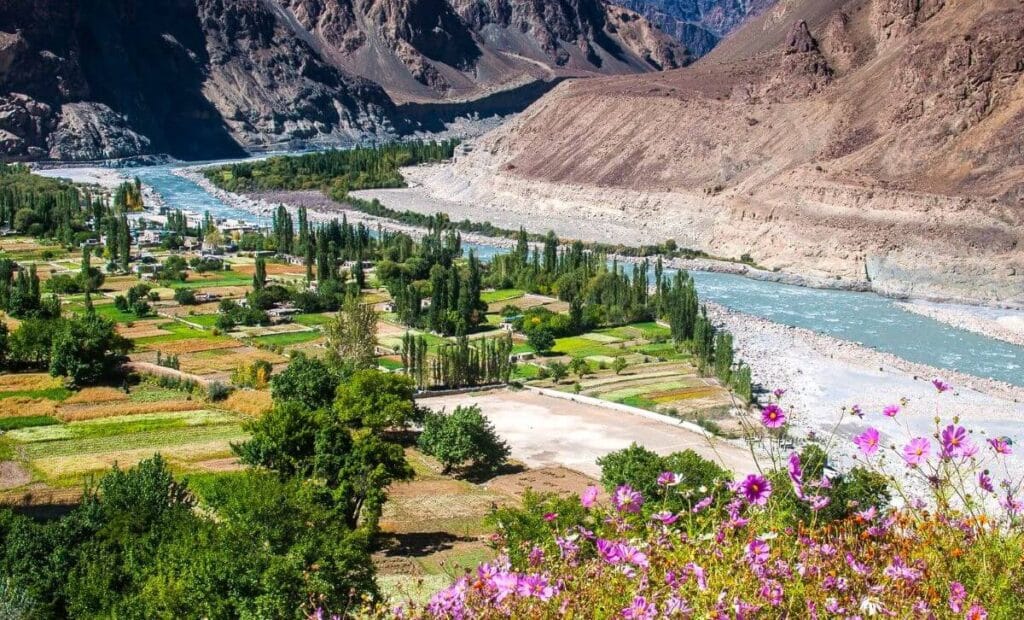
Located near the Pakistan border in the Nubra Valley, Turtuk is a charming village that offers a unique blend of Ladakhi and Balti cultures. Known for its lush orchards, green fields, and snow-capped peaks, Turtuk stands out for its contrast to the surrounding desert landscapes of Ladakh. The village, home to Balti people, follows Islam and showcases a fascinating fusion of Tibetan Buddhism and Central Asian influences.
A visit to the Turtuk Fort provides stunning views of the valley, while the serene atmosphere and warm local hospitality make it a perfect destination for trekking, photography, and cultural exploration.
Best Time to Visit: May to September
Things to Do: Explore the fort, enjoy the orchards, and experience the unique Balti culture.
Bactrian Camel Ride – A Unique Experience in Nubra Valley

A Bactrian camel ride is one of the most memorable experiences in Ladakh, especially in the Nubra Valley, where these double-humped camels roam the desert-like dunes. Unlike the single-humped dromedary camels, the Bactrian camel is native to Central Asia and thrives in the cold desert conditions of Ladakh.
Riding a Bactrian camel through the vast sand dunes of Hunder is an adventure like no other. As you glide over the soft sand, surrounded by towering mountains, you get a sense of the timeless landscape and ancient trade routes that passed through this region. The ride is peaceful and gives you a unique perspective on the rugged beauty of Ladakh.
Best Time to Visit: May to September
Things to Do: Enjoy a camel ride through the sand dunes, capture stunning photographs, and explore the Nubra Valley.
Kargil – A Historical and Scenic Stop

Located about 200 km from Leh, Kargil is a town that holds both historical significance and natural beauty. It is most famously known for the Kargil War of 1999 between India and Pakistan. The Kargil War Memorial, situated in Drass, near Kargil, is a must-visit to honor the soldiers who sacrificed their lives for the country.
Beyond its historical importance, Kargil is also a scenic destination, surrounded by lush valleys, snow-capped peaks, and rivers. The town is a gateway to several trekking routes and is ideal for nature lovers and history buffs alike. Trekking to the Suru Valley or visiting the mulbekh monastery adds to the charm of the region.
Best Time to Visit: May to September
Things to Do: Visit the Kargil War Memorial, explore the beautiful valleys, and enjoy the trekking routes.
Hemis National Park – A Wildlife Haven in Ladakh
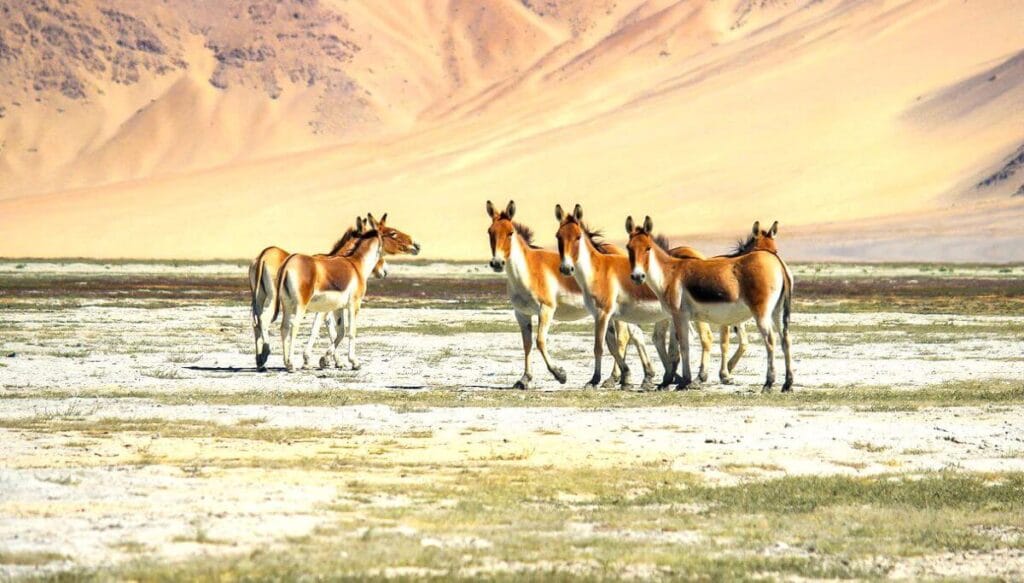
Located near Hemis Monastery, Hemis National Park is one of the largest and most biodiverse national parks in India. Spanning over 4,400 square kilometers, it is home to some of the rarest wildlife species, including the elusive snow leopard, Tibetan wolf, Himalayan brown bear, and a variety of bird species like the black-necked crane.
The park’s rugged terrain and high-altitude landscapes make it an excellent destination for wildlife enthusiasts and photographers. The best time to visit is during the summer months when the park is most accessible. While wildlife sightings can be challenging due to the park’s remote location, the scenic beauty, tranquility, and opportunity to spot rare animals make it a rewarding experience for nature lovers.
Best Time to Visit: May to September
Things to Do: Wildlife spotting, photography, trekking, and visiting nearby Hemis Monastery.
Chang La Pass – One of the Highest Motorable Roads in the World
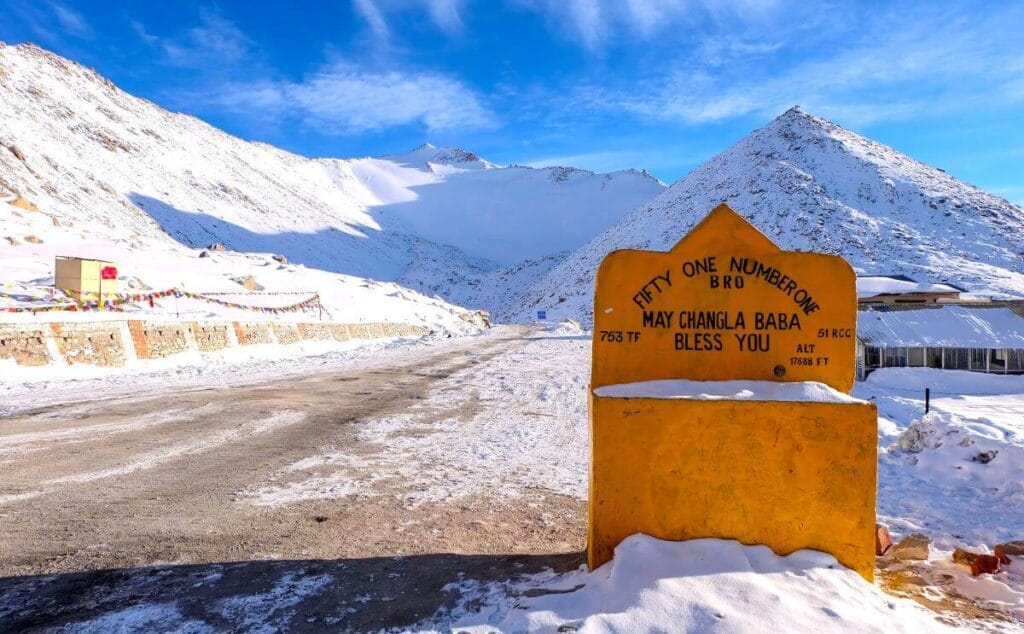
Situated at an altitude of 5,360 meters (17,590 feet), Chang La Pass is one of the highest motorable passes in the world, located on the route to Pangong Lake. The drive to this pass is an exhilarating experience, with breathtaking views of the Himalayan ranges and the surrounding barren landscape.
The pass is often covered in snow even during the summer months, adding to its majestic charm. On the way to the top, you’ll find the Chang La Temple, where locals stop to pay their respects and seek blessings for a safe journey. It’s a popular stop for travelers on their way to Pangong Lake or Nubra Valley and is a must-see for anyone looking to experience the raw beauty and altitude of Ladakh.
Best Time to Visit: May to September (though the pass remains open year-round, weather conditions can be harsh in winter)
Things to Do: Enjoy the stunning views, visit the Chang La Temple, and take photos of the panoramic landscape.
Diskit Monastery – The Heart of Nubra Valley

Located in the Nubra Valley, Diskit Monastery is one of the oldest and most prominent monasteries in Ladakh. It is famous for its large statue of Maitreya Buddha, which stands at an impressive 32 meters (105 feet), making it one of the tallest Buddha statues in the region. The monastery, founded in the 14th century, belongs to the Gelugpa sect of Tibetan Buddhism and offers stunning views of the Nubra Valley and surrounding mountains.
Visitors can explore the ancient murals, thangkas, and statues within the monastery, which reflect the rich Buddhist heritage of the region. The peaceful surroundings and spiritual ambiance make it a perfect spot for reflection and meditation. Diskit also offers a glimpse into the traditional lifestyle of the local people, who maintain a close connection with the monastery.
Best Time to Visit: May to September
Things to Do: Visit the monastery, see the Maitreya Buddha statue, and enjoy the panoramic views of Nubra Valley.
Chadar Trek – An Adventure on the Frozen Zanskar River

The Chadar Trek is one of the most thrilling and unique treks in the world. It takes adventurers along the frozen Zanskar River during winter, when the river’s surface is completely covered by a thick layer of ice (called the “Chadar”), allowing trekkers to walk on the river itself. This epic trek is a true test of endurance and offers an unparalleled experience of Ladakh’s harsh winter beauty.
The trek begins from Leh and winds through narrow gorges, ice caves, and frozen waterfalls, with the stunning Zanskar Valley surrounding you. The trek is challenging due to the extreme cold and icy terrain, but the rewards are immense: a unique opportunity to experience the remote beauty of Ladakh, interact with the locals in the Zanskar villages, and witness the frozen river’s mesmerizing landscapes.
Best Time to Visit: January to February (winter months when the river is frozen)
Things to Do: Embark on the challenging trek, explore the frozen river, and interact with the locals along the way.
Namgyal Tsemo Monastery – A Peaceful Retreat with Stunning Views
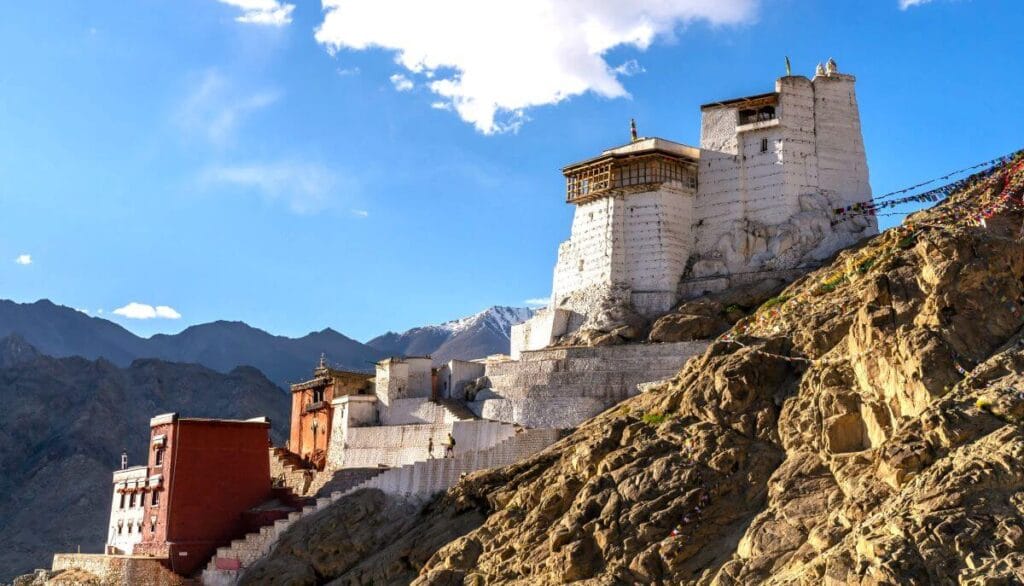
Situated on a hilltop near Leh Palace, Namgyal Tsemo Monastery offers a serene and spiritual atmosphere, along with breathtaking views of the Leh town and surrounding mountains. Founded in the 15th century by King Tashi Namgyal, this small but significant monastery belongs to the Gelugpa sect of Tibetan Buddhism.
The monastery is home to a giant statue of Maitreya Buddha, along with beautiful wall paintings, thangkas, and manuscripts. The climb to the monastery is a bit steep but rewards visitors with panoramic views of Leh, the Indus Valley, and the Himalayan ranges. It’s a perfect spot for peaceful reflection, meditation, or simply enjoying the natural beauty of Ladakh.
Best Time to Visit: May to September
Things to Do: Visit the monastery, explore the Buddha statue and murals, and enjoy the stunning views of Leh.
Druk White Lotus School – A Model of Sustainable Education

Located in the Shey region of Ladakh, Druk White Lotus School is a unique and eco-friendly educational institution that has gained international recognition. Founded by the Drukpa Lineage of the Kagyu school of Tibetan Buddhism, the school focuses on providing high-quality education to children while promoting environmental sustainability.
The school is notable for its green architecture and solar-powered buildings, which are well-suited to the harsh Ladakhi environment. The campus is designed with traditional Ladakhi and Tibetan architectural styles, using local materials to reduce the carbon footprint. The school not only provides academic education but also emphasizes cultural preservation, arts, and environmental consciousness, making it a holistic learning center for young minds.
Visiting the school offers a chance to witness how sustainable practices can be integrated into education, and it is also a great example of Ladakh’s progressive future.
Best Time to Visit: May to September
Things to Do: Visit the school to learn about its unique architecture, meet the students, and explore the eco-friendly initiatives.
Sindhu Darshan Festival – A Celebration of River Sindhu and Ladakhi Culture

The Sindhu Darshan Festival, held annually in May or June, is one of the most important cultural and spiritual festivals in Ladakh. Celebrated near the Sindhu River (also known as the Indus River), the festival honors the river’s significance in Indian culture and its importance in the region’s history. The Sindhu River is revered for its spiritual and cultural importance, and the festival provides an opportunity for both locals and tourists to come together in celebration.
During the festival, devotees gather on the banks of the river to offer prayers, perform rituals, and participate in various cultural events such as folk music and dance, traditional Ladakhi games, and local handicraft exhibitions. Pilgrims from all over India come to seek blessings, and the occasion also serves as a platform to promote Ladakhi culture and tourism.
The festival is a vibrant display of the region’s cultural diversity, making it a fascinating time to visit Ladakh and immerse oneself in the local traditions and customs.
Best Time to Visit: May or June (during the festival)
Things to Do: Attend the Sindhu Darshan Festival, participate in river rituals, and enjoy the folk performances and local crafts.
Changthang Wildlife Sanctuary – A High-altitude Haven for Wildlife
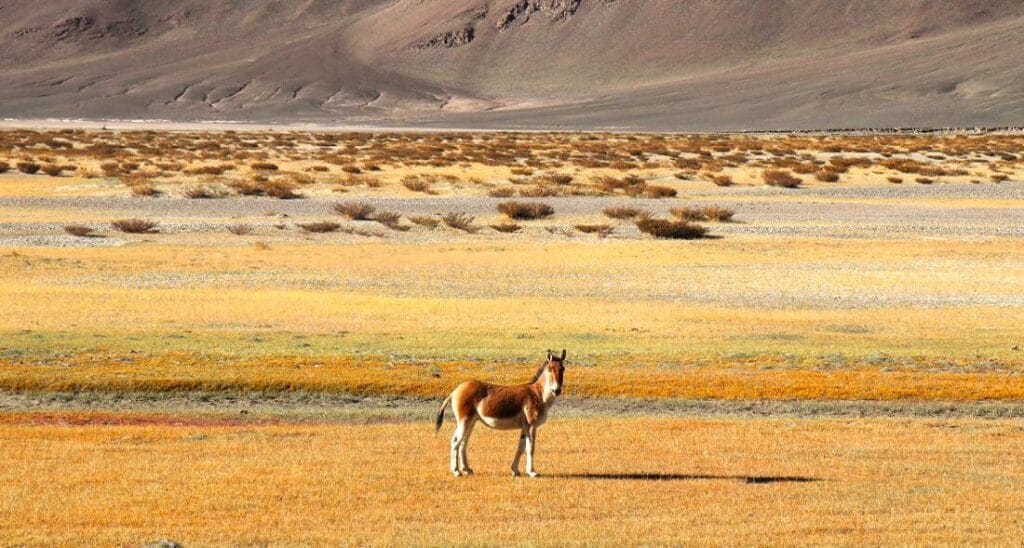
Located in the eastern part of Ladakh, Changthang Wildlife Sanctuary is a high-altitude protected area that spans over 4,000 square kilometers and is home to a variety of rare and endangered species. Situated at altitudes ranging from 4,500 to 6,500 meters, the sanctuary offers breathtaking landscapes of snow-capped mountains, desert plateaus, and high-altitude lakes, including the stunning Tso Moriri Lake.
Changthang is famous for being a habitat for the wild yak, Tibetan antelope, kiang (wild ass), snow leopard, and the black-necked crane, among others. Birdwatchers will find the sanctuary a paradise, with over 50 species of birds, including migratory birds that visit the lakes during winter.
The sanctuary is also home to the Changpa nomads, who live in harmony with the wildlife and the extreme environment. Visitors to the sanctuary can enjoy trekking, wildlife photography, and immersing themselves in the unique culture of the region.
Best Time to Visit: May to September (for wildlife sightings and trekking)
Things to Do: Wildlife spotting, birdwatching, trekking, and exploring the nomadic culture.
Mountain Biking in Ladakh – An Adventure on Rugged Terrain
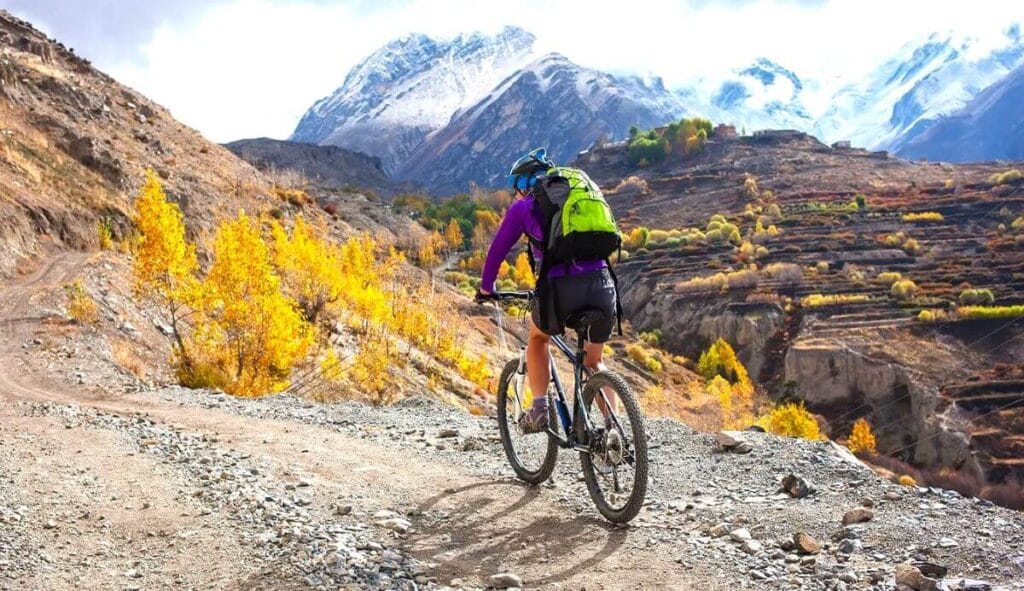
Ladakh is a paradise for mountain biking enthusiasts, offering a unique blend of challenging terrain and breathtaking landscapes. With its high-altitude roads, deserted trails, and rugged mountains, biking through Ladakh provides an unparalleled adventure for those seeking an adrenaline rush.
Some of the best routes for mountain biking include the Leh to Khardung La, one of the highest motorable passes in the world, and the route from Leh to Pangong Lake through remote villages. The Manali to Leh Highway is another popular trail, with a mix of rocky paths, streams, and high-altitude passes that test both stamina and skill.
Biking in Ladakh is not just about the thrill; it’s also about connecting with the natural beauty of the region. You’ll ride past snow-capped peaks, lakes, and desolate valleys, all while surrounded by Ladakh’s unique culture and landscapes.
Best Time to Visit: June to September
Things to Do: Take a guided mountain biking tour, explore scenic routes, and enjoy the adventure of riding through Ladakh’s rugged beauty.
Chumathang Hot Spring – A Natural Oasis of Relaxation
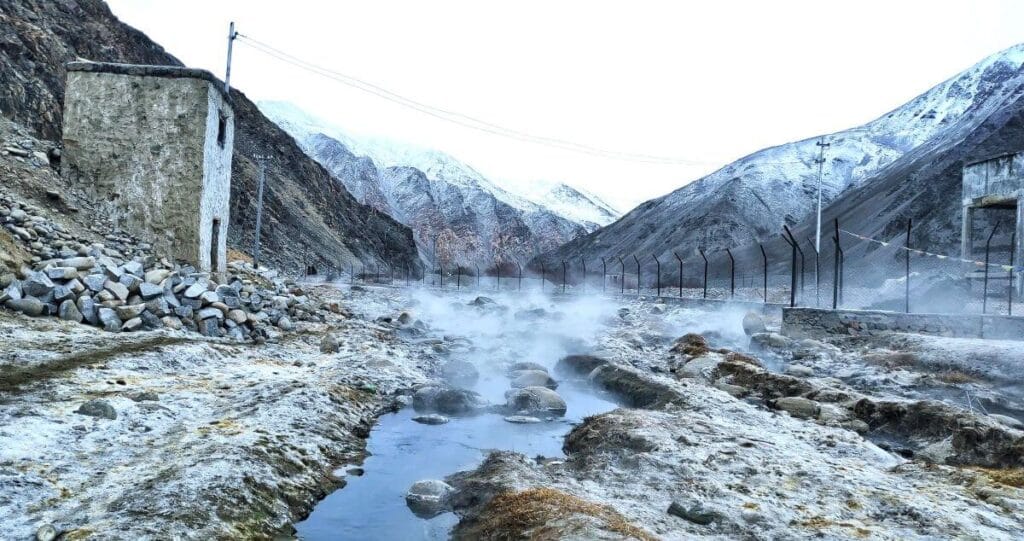
Located about 140 km from Leh, Chumathang Hot Spring is a serene and rejuvenating spot nestled along the banks of the Indus River. Known for its therapeutic hot waters, the spring has been a popular destination for centuries, offering visitors a chance to soak in natural mineral-rich hot baths that are believed to have healing properties for various ailments.
The hot springs are set in a peaceful environment, surrounded by barren mountains and green meadows. The water temperature can reach up to 80°C in some areas, and the springs are often used by locals and travelers alike for relaxation and spiritual rejuvenation. It’s also a great spot for photography, with the surrounding landscapes providing a stark yet beautiful contrast to the warm waters.
For those interested in a unique experience, the nearby Chumathang village offers a glimpse of local life, with traditional Ladakhi homes and warm hospitality.
Best Time to Visit: May to September
Things to Do: Soak in the hot springs, relax and unwind, and enjoy the scenic beauty of the area.
Darcha Padum Trek – A Trek Through Remote Zanskar Valley
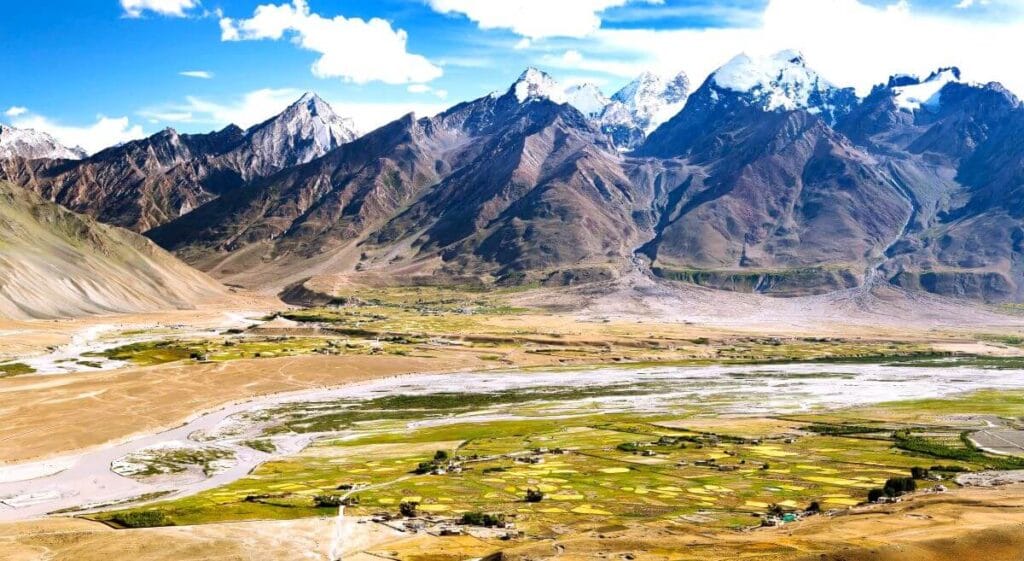
The Darcha Padum Trek is one of the most challenging and beautiful treks in Ladakh, offering a deep dive into the Zanskar Valley. This trek connects the small village of Darcha in Himachal Pradesh to Padum in Zanskar, covering a distance of about 150 km and taking around 10-12 days to complete.
The trek takes you through some of the most remote and untouched landscapes in Ladakh, including high-altitude mountain passes, pristine rivers, and desolate valleys. Along the way, trekkers can visit ancient monasteries, traditional Zanskari villages, and marvel at the stunning panoramic views of snow-capped peaks and glaciers. The trek is physically demanding and is best suited for experienced trekkers.
The Zanskar River and the surrounding rugged terrain make this trek a true adventure, allowing you to experience the wild beauty of Ladakh’s lesser-explored regions.
Best Time to Visit: June to September
Things to Do: Trek through remote valleys, visit monasteries, and enjoy breathtaking views of Zanskar’s untouched wilderness.
Maitreya Buddha – A Symbol of Peace and Hope
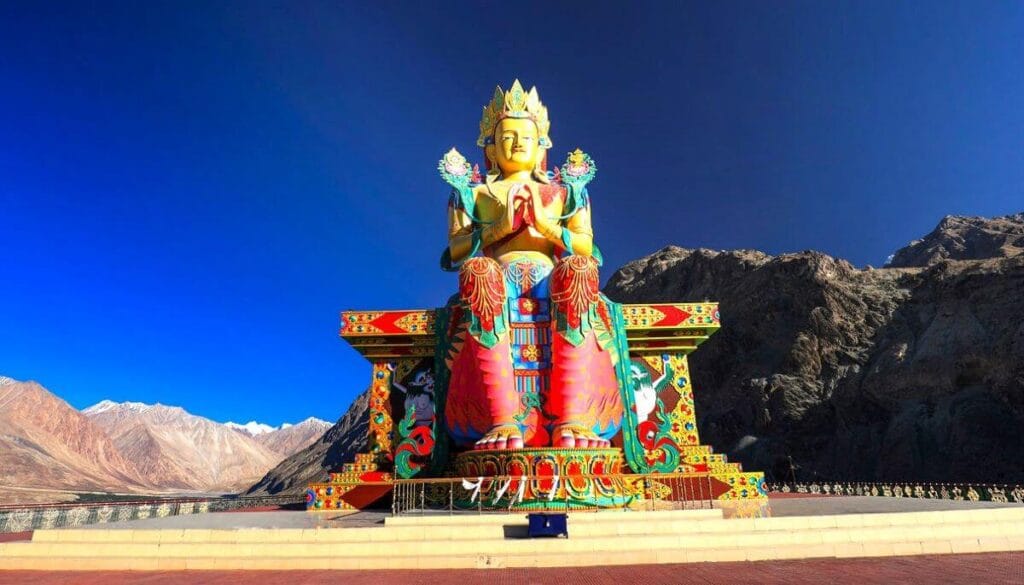
The Maitreya Buddha statues in Ladakh are among the most iconic and spiritually significant sites in the region. The Maitreya Buddha is considered the future Buddha in Mahayana Buddhism, symbolizing the hope for the future and peace for all living beings.
One of the most notable Maitreya Buddha statues can be found at the Diskit Monastery in Nubra Valley, where a towering 32-meter statue stands on a hill, overseeing the vast valley. This colossal statue is a prominent landmark and a place of pilgrimage, attracting visitors from around the world who seek its spiritual significance and stunning views of the surrounding landscape.
Another famous Maitreya Buddha statue is located at Thiksey Monastery, perched on a hilltop and offering panoramic views of the surrounding valleys and mountains. The statue’s serene expression embodies the Buddhist ideals of compassion and peace.
Best Time to Visit: May to September
Things to Do: Visit the Maitreya Buddha statues at Diskit and Thiksey Monasteries, meditate in the peaceful surroundings, and enjoy the breathtaking views.
Shyok Valley – A Hidden Gem in Ladakh
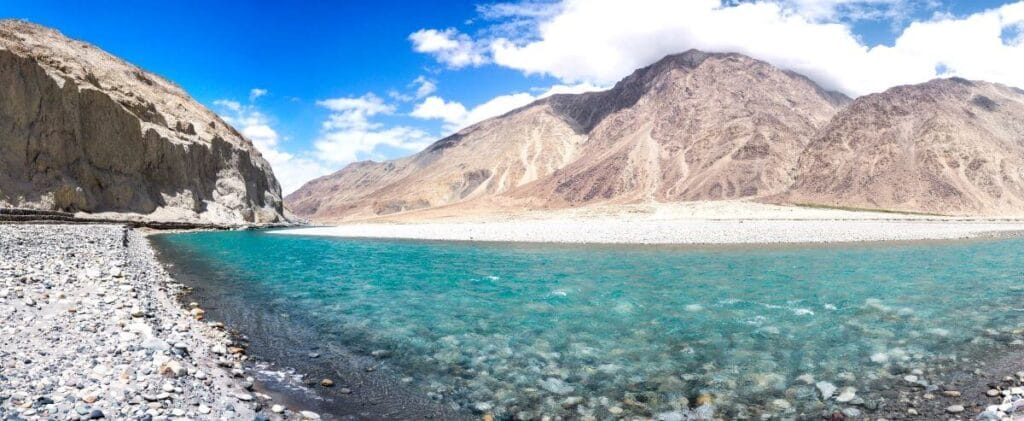
Shyok Valley, often referred to as the “River of Death”, is one of the most remote and breathtakingly beautiful valleys in Ladakh. Located in the northern region, the valley is carved by the Shyok River, which flows through rough, rugged terrain surrounded by towering peaks and glaciers. The valley offers a unique landscape, with vast plains, high-altitude deserts, and stunning river views.
The area remains relatively untouched by mass tourism, making it a perfect destination for those seeking an off-the-beaten-path adventure. Travelers can explore the Shyok River, pass through remote villages, and enjoy the tranquility of Ladakh’s wilderness. The valley is also en route to Nubra Valley, and it offers mesmerizing views of the Karakoram Range and mountain passes.
For adventure seekers, the valley is an excellent spot for trekking and road trips, with roads that provide a thrilling ride along the riverbanks. The Shyok Valley Road connects to Turtuk and Diskit, adding to its accessibility and appeal for travelers exploring Ladakh.
Best Time to Visit: May to September
Things to Do: Trekking, photography, road trips, and exploring remote villages.
Stakna Gompa – A Tranquil Monastery Overlooking the Indus Valley

Stakna Gompa is a serene Tibetan Buddhist monastery located on a hilltop overlooking the Indus River, about 25 km from Leh. The name “Stakna” means “Tiger’s Nose” in Tibetan, referring to the hill’s tiger-nose shape. The monastery offers a peaceful retreat with stunning views of the river, surrounding villages, and the Ladakhi landscape.
Founded in the 16th century by Chosje Jamyang Palkar, Stakna Gompa belongs to the Drukpa lineage and is home to a small collection of monks. The monastery houses ancient relics, thangkas, and paintings, reflecting the rich cultural heritage of Ladakh. Visitors can enjoy quiet contemplation, admire the monastery’s architecture, and take in the panoramic views of the Indus Valley.
Best Time to Visit: May to September
Things to Do: Visit the monastery, enjoy the views of the Indus River, and explore the surrounding villages.
Thang Village – The Last Indian Village in Ladakh
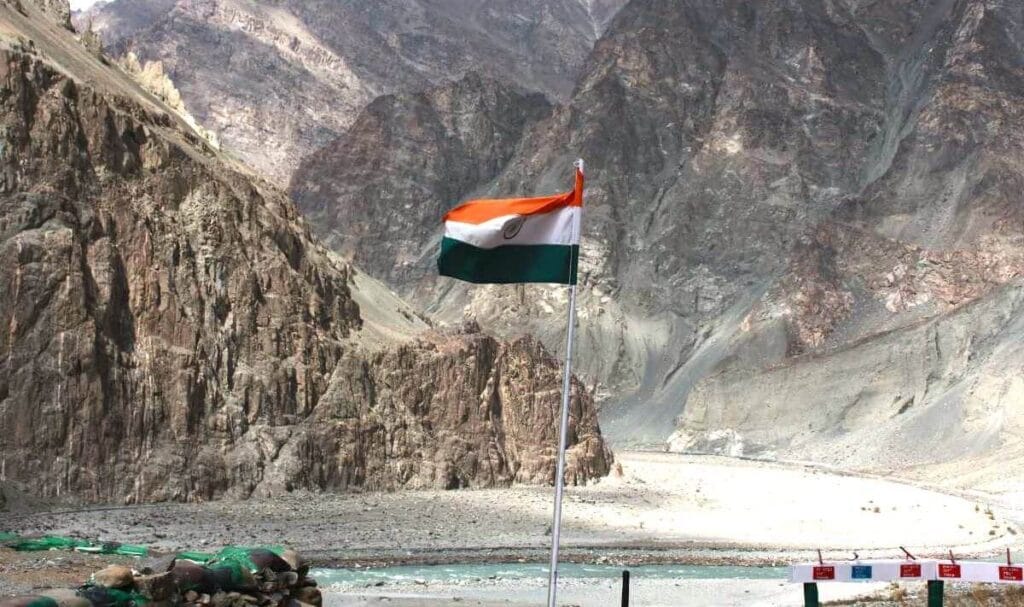
Thang Village is one of the northernmost inhabited villages of India, located near the Line of Control (LoC) in the Nubra Valley region of Ladakh. Often referred to as the “Last Indian Village”, it lies close to the India-Pakistan border and offers a rare glimpse into life at the frontier.
This remote village is home to the Balti community and provides visitors a chance to interact with locals who have preserved their unique culture and traditions. Surrounded by stunning views of the Shyok River and snow-capped peaks, Thang Village is a peaceful, offbeat destination perfect for those looking to explore untouched corners of Ladakh.
With proper permission, tourists can visit the Indo-Pak border view point, where one can spot Pakistani villages through telescopes. The experience is not only scenic but also deeply emotional and patriotic.
Best Time to Visit: May to September
Things to Do: Visit the Indo-Pak border viewpoint, explore local culture, and enjoy serene village life.
Conclusion – The Land of High Passes Awaits
Ladakh is not just a destination—it’s an experience that stays with you long after you’ve returned. From the breathtaking landscapes of Pangong Lake and Nubra Valley to the spiritual calm of ancient monasteries like Hemis and Thiksey, every corner of this high-altitude wonderland tells a story of nature, culture, and resilience.
Whether you’re an adventure seeker looking to conquer rugged treks and mountain passes, a spiritual traveler drawn to the tranquility of gompas, or someone simply looking to immerse in the beauty of the Himalayan wilderness, Ladakh has something to offer everyone.
As you plan your journey, remember to travel responsibly, respect the local traditions, and soak in the raw beauty that Ladakh so generously offers. The “Land of High Passes” welcomes you with open arms and endless horizons—are you ready for the adventure?

